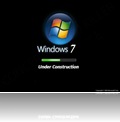We’re half way between the 3 year difference between Windows Operating Systems. The hype and rumor about Windows 7 is growing steadily, and it’s well known that Windows 7 will build on Windows Vista’s foundation. It’ll use the same driver model, provide a new native UI framework, use virtualization at a certain level, WinFX minus .Net, provide Web Services in Native Code, Ribbon UI and have tight Windows Live integration. Although it doesn’t seem like a very major upgrade, the negative image ( as created by most ) of Vista, would definitely give it a major boost. With many corporations still withholding upgrades to Vista, Windows 7 will definitely be the Windows operating system that they will have to upgrade to.
Just when we’ve started to get tidbits from insiders and reputed bloggers, we have witnessed Windows 8 being mentioned and then recently ‘Midori’. Although we have no concrete information what so ever on Windows 8, Mary Jo Foley has been providing information on what Midori would be if it sees the day of light.
An excerpt from Mary Jo Foley’s book, Microsoft 2.0:
“There’s a seemingly related (related to Singularity) project under development at Microsoft which has been hush-hush. That project, codenamed ‘Midori,’ is a new Microsoft operating-system platform that supposedly supersedes Windows. Midori is in incubation, which means it is a little closer to market than most Microsoft Research projects, but not yet close enough to be available in any kind of early preview form.
“What’s also interesting about Midori is who is running the project. One-time Gates heir-apparent Eric Rudder is heading up the effort. Midori is being incubated under Chief Research and Strategy Officer Craig Mundie’s wing. ‘Everyone under him (under Rudder on Midori) is a multi-year vet, has a super fancy title, and is going back to their roots and writing code like they probably did in the old days,’ one Microsoft tipster told me.
“When and how Microsoft will roll out Midori is still a mystery. But it sounds like the company thinks the project is serious enough to dedicate a considerable amount of time/people/resources to it.”
Being termed as a ( probable ) next gen operating system, Midori is being termed as a result of the research project ‘Singularity’, which is an OS in managed code. Microsoft has also announced that it has no plans to commercialize Singularity. Although this does not mean that they might not commercialize Midori, which they have been very ‘hush-hush’ about.
From SoftPedia
Among the current CHESS applications (work in progress), Microsoft enumerates “Dryad, library for distributed dataflow programming, Singularity/Midori (OS in managed code), user-mode drivers, Cosmos (distributed file system), [and] SQL database”. It is clear from the Microsoft Research document that Singularity and Midori are almost one and the same thing, and certainly enough, both non-Windows operating systems written entirely in managed code.
“Singularity is a new operating system being developed as a basis for more dependable system and application software. Singularity exploits advances in programming languages and tools to create an environment in which software is more likely to be built correctly, program behavior is easier to verify, and run-time failures can be contained. A key aspect of Singularity is an extension model based on Software-Isolated Processes (SIPs), which encapsulate pieces of an application or a system and provide information hiding, failure isolation, and strong interfaces,” reads a fragment of the whitepaper presenting the Singularity project.
However, there is no telling, at this point in time, where exactly Midori will end up. Microsoft might very well be working on the successor of the Windows operating system, but if it is, it has failed to give any indication in this respect. Singularity has already reached a sufficiently developed stage in order for it to be released for usage via CodePlex.
Some information on Midori and its underlying components has been mentioned in this article ‘On the road to Midori: RedHawk, MinSafe and Sapphire’ by MJ.
Redhawk and MinSafe are two sides of the same coin. Redhawk is the codename for new managed code work being done by the Developer Division, while MinSafe is the codename for the complementary managed code initiative on the Windows side of the house.
Both projects are aimed at providing a new managed-code execution environment that will be more lightweight and (Microsoft hopes) more appealing to developers who are put off by the perceived overhead of the current Common Language Runtime (CLR) at the heart of the .Net Framework.
I wouldn’t go into much detail about RedHawk, MinSafe and Sapphire yet, as the information that we have about these at the moment is not very clear. Sapphire is to show up in Windows 7, and RedHawk and MinSafe in Windows 8. One thing is for certain, Sapphire is supposed to provide managed code as native code in Windows 7, which would really ramp up development for the WPF platform to some extent.
This might go to another discussion but it seems that Microsoft will be aiming to provide WinFX minus .NET somewhat like Apple introduced Cocoa in OS X. This will surely provide increased performance and allow native developers to use code across Win32,.NET and Silverlight which would speed up adaptation.
There is still time to go for Windows 7, but the rumors for 7 and beyond are already underway. Let’s just hope that Windows 7 shatters the negative image that has unfortunately been attributed to Windows Vista.

